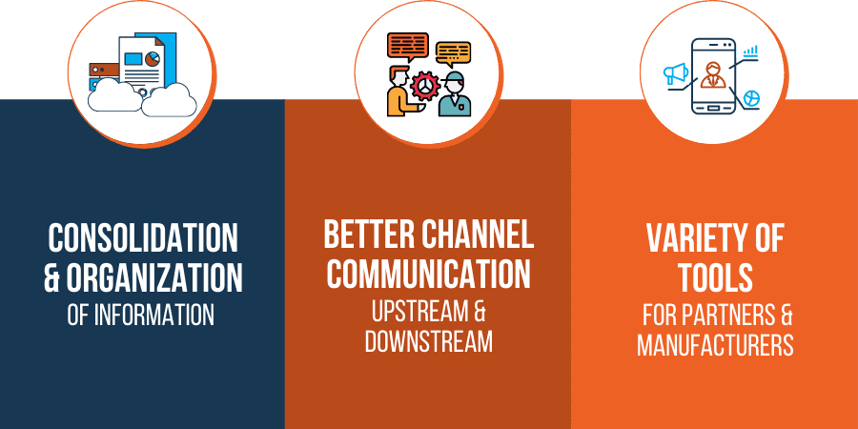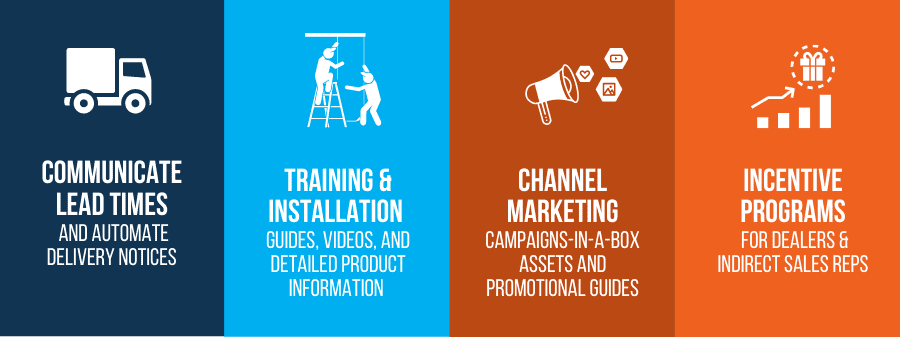
PRM or Partner Relationship Management is any combination of strategies, methodologies, software, or web applications that businesses using a distribution channel can use to communicate with their channel partners. Although they look and sound similar, PRM and CRM are not interchangeable terms, and relying only on CRM strategies and technology solutions often fall short of what channel managers (and channel partners) need to successfully get their products and services to end users.
To get started, here are the PRM terms used throughout this post:
- PRM Strategy: Any combination of PRM solutions within a business used to manage partner relationships
- PRM Solution: The tool or system, not inherently software-based, to help manage partners and partner relationships
- Technology or Platform: software, either downloadable or web-based
Who should have a PRM strategy?
Businesses who do not sell directly to their end users will benefit the most from a PRM strategy. Industries like manufacturing, building materials, automotive, insurance, SaaS, and even hospitality and recreation that sell at least in part through a distribution channel should have an effective PRM strategy.
Businesses who primarily sell to their customers should consider a CRM solution.
What is a PRM solution/technology?
While PRM is not inherently a single platform, the market for technology-based PRM solutions has grown significantly in the last ten years. PRM technologies can be downloaded software (think the Adobe or Microsoft Suites) or web- or cloud-based solutions (think Google Drive or HubSpot). While PRM technologies may vary depending on the distribution channel they’re designed for, generally they offer services like:
- Partner portal
- Content Management System (CMS)
- Sales analytics
- Incentive/loyalty program management
- Marketing and brand management
- Product information management
- Multi-language capabilities
A PRM solution is everything a channel manager needs to work with their partners combined in one place, cutting down on time spent searching through hard drives, cloud storage spaces, and even paper files.
Benefits of PRM Platforms

Consolidation & Organization of Information
One theme of 21st century technology is consolidation, and that’s what PRM technologies are offering you. PRM platforms consolidate everything your distribution channel needs, from product information to marketing guidelines to training materials, into one login. As the channel manager, you can see and manage everything from one place, and your channel partners can access everything they need from you in one place.
Better Channel Communication
Not only does a PRM platform work to consolidate and organize all the operations within your channel, a good platform will also provide efficient communication between you and your partners. The ability for partners to communicate their feedback, questions, and concerns is important, too. A PRM solution that promotes collaboration can bring in new ideas from your channel partners and address issues in a timely manner.
Variety of Tools for Partners & Manufacturers
Not every PRM platform will have all these resources, but here’s a rundown of some things you might want to be looking for:
- Partner Portal: This is what your partners will see when they login. A partner portal provides access to all the materials you give partners. This could be marketing and branding guidelines, access to apply for and track a loyalty program, training or certification materials, and product information, pricing, and inventory.
- Product information: Upload and update product information as necessary.
- Sales Analytics: Track each partner on their goals or view overall product sales.
- Incentive/loyalty program management: Set up an incentive program to encourage sales of your product or service, then track partner progress and implement rewards.
- Marketing and Brand Management: Set guidelines for how your partners use your logos and marketing materials.
- Training and Certification: Provide access to training videos or online certification to help partners better understand your product.
- Automation: A PRM platform could automate some functions to save time. Say you add a new product to your platform or upload a new training video—you could set up an email automation where all of your partners get a notification to their inbox of certain changes.
Selecting a PRM platform
If your current PRM strategy is bogging you and your partners down and you struggle managing things like tracking partner sales goals, marketing and branding consistency, and implementing a loyalty program, it’s time to consider a new PRM solution. But where should you start?
Not all distribution channels are the same, and different PRM technologies are built for different sizes and shapes of channels, and for different industries. Three things to consider when you start your PRM technology search:
- Size of your channel (and how big you’d like it to grow)
- Your industry
- Budget
Size of your channel
Everyone wants their business to grow, but how big your channel currently is will help determine what you need right now and in the near future to start your PRM solution. Some PRM solutions are built for small, start-up channels, while others have huge, international channels in mind with capabilities to work in multiple languages and across many boarders. If your channel is currently experiencing rapid growth, look for a PRM solution that grows with you or allows you to add on tools as you need them.
Larger channels might have some existing PRM systems, and completely overhauling the channel flow isn’t possible. Look for a PRM solution that can integrate with other software.
Your Industry
Not every channel has the same needs, so not every PRM technology offers the same functions. A building materials manufacturer might be looking to implement an incentive program for distribution partners or connect contractors with valuable installation and support materials.
Budget
Money is almost always an object. Consider what you need out of a PRM the most and the soonest, and if there are options to acquire additional modules later.
Also consider the price of licensing out to your partners. Does a solution charge per individual partner or do the prices go up incrementally (price per 50, price per 500)?
Then consider the internal and/or external resources that will be required to setup of your PRM out of the box and with any custom features.
PRM Platforms to consider
Some popular PRM technology solutions:
-
- MindMatrix
- Oracle Partner Portal
- Salesforce PRM
- Impartner
- Zinfi
- PartnerStack
- Allbound
Best Use Cases of a Partner Portal for Manufacturers

Communicate Order Lead Times and Shipment Notices
Because a partner portal's database is dynamic and often hosted on the cloud, you can provide real-time product lead status's and delivery information to your partners. This is critical as dealers and distributors need know when they will have inventory back in stock for their customers and customers need to know whether or not to wait a couple days or find an alternative source for their current project. Learn more about solving for lead time communication.
Training & Installation Information
Your partner portal is the best place for information regarding training and installation for your products. Contractors and builders can complete courses to earn certifications in your products or use installation guides and videos on-site via a mobile device to ensure your product was installed correctly and performs as expected for the customer.
Marketing Campaigns-in-a-Box
Marketing gets tricky though the channel, to say the least. A partner portal with a selection of pre-set campaigns gives your channel partners the power to market effectively for you. A partner portal with built-in marketing automation makes marketing even easier with the ability launch a campaign as a partner and monitor the results.
Generating Demand With Dealer Incentives
Dealer incentive programs have been around for some time, but a partner portal gives both dealers and manufacturers more capability to execute and track incentives. A partner portal can give manufacturers the tools to build, implement, and track incentive programs, as well as offer different types of incentives beyond Amazon gift cards and marketing dollars. At the end of the day, a good incentive program motivates the individual humans with boots on the ground at your dealer showrooms and distribution centers. A PRM ensure you can track and analyze individualized data to improve your incentive programs.
Certain PRM platforms allow manufacturers to create rewards programs that track specific team members at their partner companies to reward top sellers or encourage additional training among contractors.
Next Steps
Identify the gaps in your current PRM strategy and prioritize what needs to be addressed first and what resources you can allot to adapting a new system.
PRM shouldn’t have to be stressful, and PRM platforms are made to consolidate and simplify the ways you work with your channel partners. If you’re spending less time tracking down information or making sure it gets to your partners, your entire channel can spend more time getting your product in the hands of your ideal end users.
If you're looking to keep your channel management all in one place using the HubSpot CRM, take a look at our Partner Deals Portal App, which syncs indirect sales deal registration directly into your own HubSpot sales pipeline so you can manage true sales forecasts. Learn more >>




